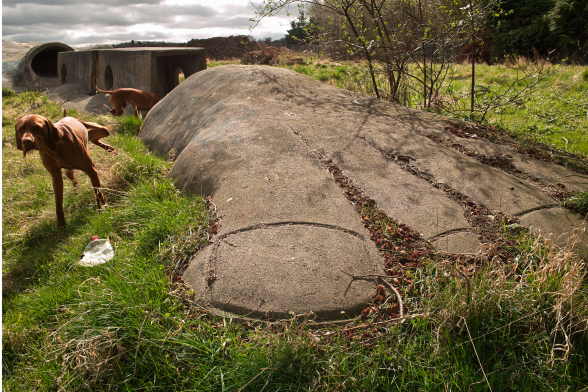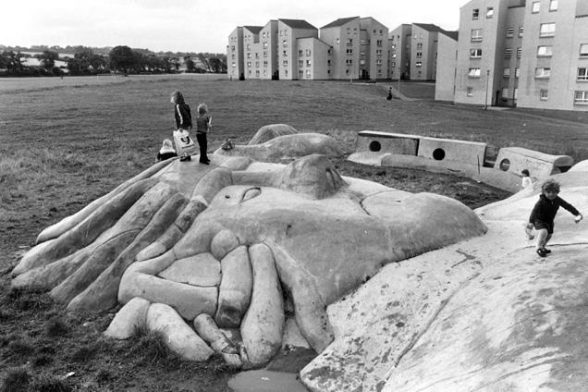This website uses cookies
This website uses cookies to enable it to function properly and to analyse how the website is used. Please click 'Close' to accept and continue using the website.



Image: Andrew James Black
C20 is pleased to see Gulliver’s foot – once part of a far larger figurative concrete play-sculpture – belatedly recognised with listing. ‘The gentle giant who shares and cares’ artwork was created in Craigmillar, Edinburgh between 1976-78, becoming an unlikely landmark of British outsider art and community-led regeneration. The Society first submitted the sculpture in its entirety for listing in 2007, this attempt was sadly unsuccessful and most of Gulliver was demolished in 2011. Historic Environment Scotland have now elected to protect the the last remaining fragment, listing at Category C in recognition of its historic and cultural significance.
Craigmillar is a planned housing estate on the outskirts of Edinburgh that was built in the 1930s. Yet within forty years, the optimism of the Interwar era had dissipated, the estate had fallen into disorder and by the 1970s ‘Craigmillar’ had become a by-word for deprivation. The Craigmillar Festival Society was formed to change this dire situation and became one of the most notable community-led regeneration schemes of its time, achieving international acclaim for their work. At the centre of this movement was the idea to build an interactive piece of public art, that would also function as a place for the local children to explore and play.

Source uknown
Inmate turned artist
Craigmillar Festival Society controversially commissioned ‘outsider’ artist Jimmy Boyle (b.1944) to design the sculpture of Gulliver. Boyle was a notorious gangster and moneylender from the Gorbals, who was serving a life sentence for the murder of a gangland rival in 1967. While an incarcerated, Boyle underwent a much publicised rehabilitation, discovering an interest in sculpture. On leaving prison in 1981, he would go on to carve out a successful career as both an artist and an author, also setting up the Gateway Exchange – a project aimed at helping to keep vulnerable young people off drugs.
The Gulliver sculpture, known as ‘The gentle giant who shares and cares’, was inspired by the protagonist from Jonathan Swift’s 1726 satirical novel, Gulliver’s Travels. Measuring approximately 100ft from head to toe and built as a simple and robust concrete shell construction; the arms, legs and torso contained a series of tunnels and hideaways, all constructed by local young people and adults under the festival’s job creation scheme.
Upon completion, the artwork was unveiled Billy Connolly. It was believed to have been the longest concrete sculpture in Europe. In 2004 Boyle noted that he intended the sculpture to be ‘a symbol of that particular period when disadvantaged communities were for the first time demanding to be heard’.

Image: Andrew James Black
Listing attempt and loss
Craigmillar is located in a slope between two watercourses the Braid Burn and the Niddrie Burn, in Hunters Hall Park, to the South East of Edinburgh. As part of flood prevention measures in the area to support additional housing development, plans were announced in 2006 to the reroute the course of Niddrie Burn, running straight through Gulliver’s site. Due to the fragility of the sculpture, relocation was not deemed feasible by the developer and the local council, triggering a listing attempt by C20 Society.
At less than 30 years old the sculpture was below the date threshold at which a building or structure can normally be considered for listing and with the ‘level of understanding’ at Historic Scotland that time, was not found to meet the criteria of special architectural merit, leading to most of Gulliver being demolished in 2011.
As part of the flood prevention landscaping, a small surviving fragment of the sculpture was retained in-situ, consisting of a left foot with indented toes and incised toenail detailing, along with a detached rectangular box-tunnel section that formed part of the figure’s left leg. The side walls of the tunnel section each have window-like circular opening (one damaged) and are secured within a smoothly rendered concrete base.
Despite its denuded state, C20s Casework Committee considered that the sculpture still retains its significance as testament of the importance of the community in Craigmillar, and thus supported its national listing. We hope its retention will help to tell the story of the sculpture from a widely used primative play structure to a neglected, and then almost lost, monument.

Image: BD Online

Become a C20 member today and help save our modern design heritage.